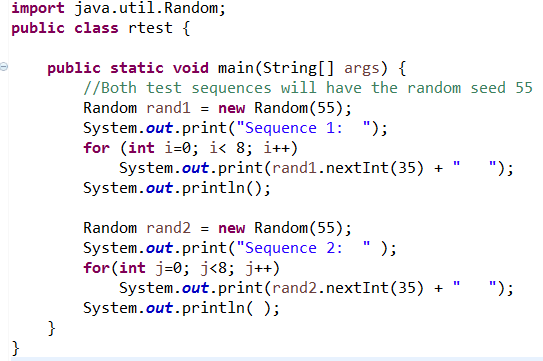

- #MATH.RANDOM JAVA HOW TO#
- #MATH.RANDOM JAVA GENERATOR#
- #MATH.RANDOM JAVA CODE#
- #MATH.RANDOM JAVA CRACK#
#MATH.RANDOM JAVA HOW TO#
Those are the instructions, it’s up to the browser to decide how to follow them.
#MATH.RANDOM JAVA CODE#
This function takes no arguments.Įach Math.random function created for distinct code Realms must produce a distinct sequence of values from successive calls. Returns a Number value with positive sign, greater than or equal to 0 but less than 1, chosen randomly or pseudo randomly with approximately uniform distribution over that range, using an implementation-dependent algorithm or strategy. Instead, the engineers who created your browser decided on an algorithm to use that conforms to the ECMAScript spec, which is as follows: There’s no hard-coded PRNG algorithm that ships with JavaScript. JavaScript doesn’t decide how Math.random() gets implemented, your browser does. So now the question is: what PRNG does JavaScript use?
#MATH.RANDOM JAVA CRACK#
more resource intensive) for a computer to crack / predict a fact that has security implications even though no one should be using Math.random() for encryption - but it happens anyways. Not only does a PRNG with a long period seem more random to us humans but it’s also harder (i.e. The quality of a PRNG depends on a number of factors, a very significant factor being something called its period the number of iterations a PRNG goes through before it starts repeating itself.

If you’re using math and formulae to create a sequence of numbers, random though they might seem, those numbers will eventually repeat and reveal a non-random pattern.īut some PRNGs are better than others. It just does a really good job of simulating randomness.Īlgorithmic random number generation can’t exactly be random, per se which is why they’re more aptly called pseudo-random number generators (PRNGs).

Surprise surprise, the answer is that Math.random() doesn’t really generate a random number. So what happens when you want to generate a ‘random’ number? How does that even work and what’s happening behind the scenes? For starters, it’s not really random And, more importantly, how can they possibly be random? After all, don’t computers just take in some input, swirl it around with some math, and then spit it back out? Seems like a pretty predictable process. I’ve always wondered where on earth these numbers come from. Open up your dev tools’ (Mac: cmd + option + i / Windows: ctrl + shift + i), go to the Console, type Math.random() , and hit return.

#MATH.RANDOM JAVA GENERATOR#
Purpose: To learn how to declare and use a random integer generator


 0 kommentar(er)
0 kommentar(er)
